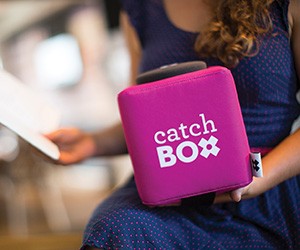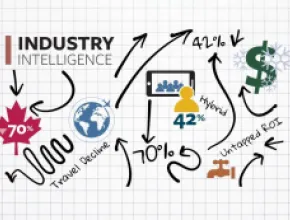With audience engagement a pressing priority these days, it’s little wonder if traditional approaches to everything from tradeshow set-ups to teambuilding exercises are getting turned on their heads. Here are 10 suggestions from a broad spectrum of industry experts on easy-but-innovative ways to turn apathetic attendees into pleased participants.
1) Less Lecture Time
At any session these days, attendees are always just a few seconds away from tuning out and turning to their mobile devices, notes Shawna Suckow, founder of the Senior Planners Industry Network (SPIN). As a result, planners need to provide content in a more dynamic way, starting with doing away with the full-session lecture.
“Today’s audiences do not want to be lectured for three days, not even three hours,” she says. “My sessions these days are no more than half lecture, sometimes not even that.”
Instead, Suckow works with speakers to design sessions where interaction will be key, not only between the speaker and the attendees but between the attendees themselves. One method is the use of the Catchbox, a square-shaped, throwable microphone that gets tossed among attendees during discussions.
“Everyone really pays attention when the Catchbox is being tossed around the room—no one wants to get hit with it,” Suckow says. “It keeps everyone involved and on their toes.”
2) Reach out to First-Timers
Those most vulnerable to disengagement are first-time attendees and industry newcomers, according to Suckow. She recommends organizing a special networking event for them, possibly consulting with a networking strategist on the best way to facilitate it.
“It’s especially important to engage new attendees, to help them get together and form their own tribe,” she says. “Everyone wants a tribe to attend things with.”
3) Rethink the Meeting Room
When it comes to room set-ups, Dr. Paul Radde, an organizational development consultant, keynote speaker and author of Seating Matters, has no enthusiasm for its two most prevalent forms: theater-style seating and banquet-style seating at large round tables. Instead, he favors alternatives such as curved rows of seating or tables in a rectangular or trapezoidal shape.
“By curving the rows, not only do people get a better view of the presenter, but you increase the dynamics in the room,” he says. “The people in the audience get a better view of each other; they can see each other’s reactions. It gets people to pay more attention and encourages them to talk with each other during the break.”
When it comes to the typical six- or 10-foot table rounds used at many banquets, Radde sees them as wasteful of the room space and an almost fool-proof guarantee that people will not be able to network with each other. “Everyone is so far from each other that the most you can do is nod at someone,” he says. “With rectangles, people are not as far apart. Plus, it’s easier for the speaker to walk through the room and engage people.”
4) Rethink the Show Floor
The traditional tradeshow set-up of booths on a grid pattern is far from the most engaging use of the space, says Dana Freker Doody, vice president of communications for the ExpoGroup.
“People are really questioning all those up-and-down aisles at right angles,” she says. “We had a client do a diagonal row right down the center of the exhibit hall and it really opened up the lines of sight for the exhibitors. Plus, we created some odd-angled spaces that could serve as community chatting areas, places where micro audiences could come together.”
5) Consider Tradeshow Wearables
At huge conventions and tradeshows, it can be difficult for people to navigate their way through the throngs of exhibitors and attendees and search out those they’d most like to connect with. An effective way to surmount this is through wearable technology such as smart name badges and bracelets using RFID (radio frequency identification), NFC (near field communication) or beacons, says meetings tech consultant Corbin Ball.
Ball is equally enthused about the possible uses of Virtual Reality headsets, which he sees “being used to demonstrate products at a tradeshow in a more realistic, interactive and engaging manner while minimizing the need to ship physical products to a show.”
PageBreak
6) Rethink Food Choices
Food and beverage planning is becoming increasingly more complicated, what with the plethora of dietary restrictions and preferences as well as greater expectations about food quality and presentation, according to Patti Shock, a meetings consultant and professor emeritus at the University of Nevada, Las Vegas.
While pleasing everyone can be difficult, especially at banquets with a fixed menu, one way to improve the odds is to offer a split entree, perhaps pairing lamb with seafood, she says.
“It’s a way you can introduce something not widely accepted or even exotic, while still offering standard,” she says. “Attendees will have at least half of an entree they want to eat and may be able to trade what they don’t want with another attendee.”
7) Music to Energize
With a background in entertainment, Thomas Pitchford, owner of Pitch Perfect Events, appreciates the power of music to set the mood for an event and energize attendees. Generic “elevator music” played in the background does not do the trick, he says.
“I like to look at the event as a theatrical presentation that tells a story,” he says. “The music should be related to the theme of the conference or event and be upbeat. During breaks, we might want offer music that energizes and keeps minds focused. Everyone loves music, so it should be more than an afterthought.”
8) Surprising Gifts
Instead of handing out swag bags to guests, all to often filled with tchotchkes that people already have or have no use for, Pitchford advises making gifts part of interchanges with the audience that have an element of fun and surprise.
“One way to do this is through a pop-up trivia contest,” he says. “Or you can ask for a volunteer from the audience. He comes up on stage and the president gives him a hundred-dollar bill. Or find a person in the audience who has an identical twin or give a gift to the last person who registered.”
With this alternative to gift bags, the budget is directed toward a few larger prizes such as gift cards to restaurants or for maid service rather than “thousands of little items nobody really wants,” Pitchford says.
9) Everybody In
When it comes to teambuilding, everyone at the event, including top management, needs to be a participant, says Meredith Martini, founder of PlayWorks Group, an event management company.
“An important thing about teambuilding is that it levels the playing field,” she says. “No one has previous experience in building a sculpture out of canned goods. There’s no fear of failure. You get to see your co-workers in a different light. It creates new relationships and dialog to build connections.”
Much of this is diminished when the executives go into another room or stand in the back of the room to watch.
“This sends a poor message to the employees—it’s teambuilding in a fishbowl,” she says. “Do not separate the executives from the others. When people are exempted because of their status on the food chain, it sends the wrong message and dumbs down the purpose.”
10) Consider the Virtual Audience
With many sessions being live streamed or recorded for future on-demand reference, special attention needs to be paid to engaging the virtual audience, says Emilie Barta, a tradeshow and hybrid meetings consultant.
“Speakers are having a hard enough time creating an interactive session for those sitting before them, let alone with those who will be participating virtually,” she says. “You need to ask them if they are willing to create a session that can be live-streamed.”
If speakers are uncomfortable with the idea or if the planner determines that they will not translate well on camera, it’s better to not to stream the sessions, according to Barta.
Even if the session will simply be recorded, many speakers will benefit from expert guidance on how to make eye contact with the camera, wear the right clothing, not walk out of the lighting, and otherwise “remember that they’re on TV,” she adds.
In particular, sessions with a virtual component require careful audiovisual consideration, Barta says.
“Before you order the audiovisual items, you really have to design the experience and make a plan,” she says. “The audiovisual has to put the speaker and the session in the best light.”







